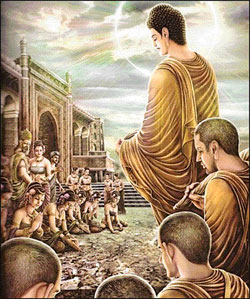|
The Buddha and His Dhamma
As we prepare to celebrate the most hallowed event in Buddhism, Vesak
let us reflect on some important facts relating to the sacred life of
the Buddha, the Enlightened One...

Fact file
* Gautama Buddha, the historical Buddha, lived between 624 and 544 BC
in the area known now as the Indo-Nepalese region.
* Tathagata means - the One who has found the Truth.
* According to ancient tradition, Queen Maya, his mother, first had a
dream of a beautiful white elephant coming down into her womb, and this
was interpreted as a sign that the Buddha, or a universal emperor, was
about to be born. When her time came, Queen Maya went into the garden
and gave painless birth to the Bodhisattva.
* As a Bodhisattva, he had passed through thousands of existences
before coming to Earth for his ultimate life-span.
* Five days after his birth, the young prince received the name of
Siddhartha.
* The Buddha touched His goal of Enlightenment after meditating for
forty days under a Bodhi tree. Alone and weak, he sat beneath the Sacred
Bodhi tree of wisdom, and resolved to attain Enlightenment before
arising.
* He delivered his first sermon in the deer park at Saranath.
* According to Buddhism, there are "four noble truths": (1) existence
is suffering; (2) this suffering is caused by human craving; (3) there
is a cessation of the suffering, which is nirvana; and (4) nirvana can
be achieved, in this or future lives, though the "eightfold path" of
right views, right resolve, right speech, right action, right
livelihood, right effort, right mindfulness, and right concentration.
* Through his process of Enlightenment He discovered that all
sentient beings in this universal life possess Buddhahood, and all are
future potential Buddhas.
* It is said in the Maha Parinibbana Sutta that Buddha himself
identified four places of future pilgrimage: the sites of His Birth,
Enlightenment, first discourse, and Parinibbana.
* In 249 BC, when the Emperor Ashoka visited Lumbini it was a
flourishing village.
The emperor constructed four stupas and a stone pillar with a figure
of a horse on top.
Lumbini remained neglected for centuries. In 1895, Feuhrer, a famous
German archaeologist, discovered the great pillar while wandering about
the foothills of the Churia range.
Further exploration and excavation of the surrounding area revealed
the existence of a brick temple and a sandstone sculpture within the
temple itself which depicts the scenes of the Buddha's birth.
* In 1996, an archaeological dig unearthed a "flawless stone" placed
there by the Indian Emperor Ashoka in 249 BC to mark the precise
location of the Buddha's birth more than 2,600 years ago, if
authenticated, the find will put Lumbini even more prominently on the
map for millions of religious pilgrims. Buddhism eventually spread from
India to Central and Southeast Asia, China, Korea, Japan, and, in the
20th century, to the West.
Today, there are an estimated 350 million people in over 100 nations
who adhere to Buddhist beliefs and practices. |

